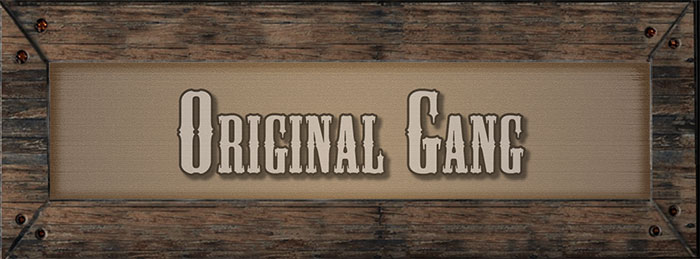
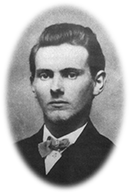 Jesse James
Jesse James
Jesse Woodson James was born September 5, 1847 in Kearney, Missouri. He rode with a Confederate guerrilla group under “Bloody Bill” Anderson in 1864-1865. In 1865, Jesse lost a lung when he was shot, for the second time, in the chest while trying to surrender.
From 1866 – 1882, numerous bank and train robberies were attributed to the James-Younger gang. Jesse wrote letters to several newspapers proclaiming his innocence in robberies they were accused of. With the assistance of newspaper editor John Newman Edwards, Jesse created an image of himself as a noble and innocent former Confederate soldier who was being singled out by the Yankees. The James-Younger gang enjoyed the support of many people in Missouri due to a Robin Hood persona that Edwards created in his newspapers and the feeling that “the boys” were fighting against untrustworthy banks and railroad companies.
Jesse married his first cousin, Zerelda A. Mimms, in April, 1874. They had four children – Jesse Edwards, Mary and twin boys who died in infancy. An ill-fated bank robbery in Northfield, Minnesota on September 7, 1876 led to the Youngers being captured. Jesse stopped robbing for three years and took up farming under an alias in Tennessee. After incurring debts due to his poor health, gambling losses and unsuccessful farming, Jesse returned to a life of crime. In 1879, Jesse put together a new gang and began robbing trains. These men were not as reliable as the Younger brothers and did not share the brotherhood from being soldiers in the Civil War. Jesse James was killed at his home on April 3, 1882 in St. Joseph, Missouri when a new member of his gang, Robert Ford, shot him in the back of the head. He was 34 years old.
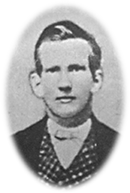 Frank James
Frank James
Alexander Franklin James was born January 10, 1843 in Clay County, Missouri. At the age of 18, Frank joined the Missouri State Guard and fought against the Union army. After he was captured in Springfield, Frank was paroled and he returned home on bond. He broke his bond to join the Partisan Ranger forces of William Quantrill in 1862. While with Quantrill, Frank became good friends with Cole Younger. Frank took part in numerous engagements including Wilson’s Creek and the Centralia raid. After his surrender in Kentucky at the end of the Civil War, Frank returned to the family farm in Clay County. He was accused of joining Cole Younger and other former members of Quantrill’s group to rob the bank in Liberty, Missouri on February 13, 1866. This was the first daylight, peacetime bank robbery in the United States and, several years later, the first robbery attributed to the James-Younger gang.
Frank loved Shakespeare. He was a quiet man and was happy to let his more gregarious brother, Jesse, be the public leader of the gang. Frank may have instigated the train robbery at Gad’s Hill, Missouri. The passengers recalled a bandit quoting Shakespeare during the robbery. Frank married Annie Ralston in June, 1874. They had one son, Robert Franklin and a daughter who died in infancy. Historians believe Frank was the bandit that killed Joseph Heywood in the ill-fated Northfield, Minnesota bank robbery.
Frank lived with his family under an alias for four years in Tennessee. He was a farmer and worked hauling lumber. He was disappointed that Jesse returned to a life of crime but he gave up his normal life in Tennessee and joined his brother.
Frank was in Baltimore, Maryland when he heard that Jesse had been killed; with the help of John N. Edwards he surrendered to the governor of Missouri in October, 1882. Frank stood trial a couple of times in Missouri and once in Alabama but was found not guilty. Jurors were influenced by the perception that Jesse had been murdered by order of the Governor of Missouri and they felt Frank should go free; he spent the rest of his life working in stores, farming and taking care of the family farm. Frank starred with Cole Younger in a Wild West show during 1903 and after many years of living a peaceful, honorable life, he died February 15, 1915 at the family farm in Kearney, Missouri.
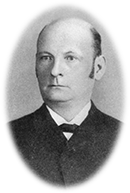
Cole Younger
Thomas Coleman Younger was born on January 15, 1844 in Lee’s Summit, Missouri. After a Union Captain insulted his sisters and accused him of riding with Quantrill’s guerrillas, Cole left home in late 1861. He and his brother-in-law, John Jarrett, joined Quantrill in January of 1862. Cole was in numerous battles, including the raid on Lawrence, Kansas. He joined the regular Confederate army in late 1863 and rose to the rank of Captain. He and Jarrett were sent to chase cotton thieves in Louisiana during the fall of 1863. Cole was in the Pacific Northwest when the Civil War ended.
Cole’s father had been murdered during the war and his family lost much of its wealth and property. Vigilantes were after Cole due to his prominent role with the Confederate army. He decided it wasn’t safe to remain home but he had to take care of his widowed mother and underage siblings. He and other men like him had few options to earn money. Cole and John Jarrett have been accused of being the instigators of the February 13, 1866 bank robbery in Liberty, Missouri.
When not robbing banks and trains with the James brothers, Cole ran cattle in Louisiana and Texas. While living in Texas with his family, Cole claimed that in 1870 he and his brother Jim were census takers, however, no evidence has been found to support this. Like Jesse James, Cole would write letters to the newspapers. Cole claimed that he disliked Jesse James but put up with him because of his friendship with Frank.
More than a week after the Northfield, Minnesota bank robbery, Cole and his brothers were captured. They pled guilty to being accessories to the murder of Joseph Heywood and robbing the Northfield bank which gave them life sentences instead of hanging. In prison, Cole worked hard in the hospital, library and with the newspaper. He continued to write letters to family, friends and newspapers.
Cole was released in 1901 but had to stay in Minnesota. He was allowed to leave the state never to return in February, 1903. He joined Frank James in a traveling Wild West show although he had to keep in the background due to terms of his parole. Cole wrote an entertaining but historically questionable autobiography that was published in 1903. He also travelled around the Midwest giving lectures on what life had taught him. Cole died on March 21, 1916 in the Lee’s Summit home of his niece.
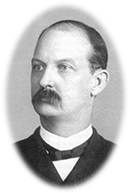
Jim Younger
James Hardin Younger was born January 15, 1848 in Lee’s Summit, Missouri. In late 1864, Jim joined with William Clarke Quantrill. He was captured in May, 1865 with Quantrill in Kentucky and sent to the Alton prison where he was held until he took the loyalty oath in late 1865. In 1873, his brothers persuaded him to join the James-Younger gang on their first train robbery near Adair, Iowa.
Jim and his brother John were involved in a gunfight with Pinkerton detectives on March 17, 1874 near Roscoe, Missouri. John was killed but Jim was not wounded. He went to California where he first visited with his uncle Coleman Younger and then went to work for Drury James, uncle of the James brothers. In 1876, Jim was persuaded to join the gang for a bank robbery in Minnesota. During their escape from Northfield, Jim was shot in the face and his jaw was shattered, he was not able to eat solid food for the rest of his life. Jim and his brothers were captured and sentenced to life in prison. Jim started one of the first prisoner run newspapers in the country.
Jim and Cole were released on limited parole in 1901. He was denied a request to marry his girlfriend, Alix J. Mueller and, due to ill health, Jim was not able to hold a job. Despondent over his lack of freedom, Jim committed suicide on October 19, 1902.
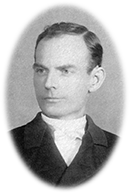
Bob Younger
Robert Ewing Younger was born October 29, 1853 in Lee’s Summit, Missouri. Bob was too young to fight in the Civil War but suffered through the attacks on his family and the murder of his father. He joined the family in Texas where he enjoyed farming. He travelled around the country on money Cole had given him to go to college. Bob became good friends with Jesse James who influenced Bob to join him in persuading his brothers to rob a bank in Minnesota.
Bob was shot in the elbow which broke his arm during the ill-fated Northfield, Minnesota bank robbery on September 7, 1876. Two weeks later he was shot in the chest while waving a white flag trying to surrender after a posse surrounded the brothers and Charlie Pitts at Hanska slough. He and his brothers were sentenced to life in prison. Bob developed tuberculosis while in prison and died in Stillwater Penitentiary on September 16, 1889.
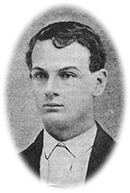 John Younger
John Younger
John Harrison Younger was born in 1851. John was too young to fight in the Civil War with his brothers. In 1865, John was tried for killing a man who had attacked him but the court found him innocent because he acted in self-defense. John was hung by vigilantes who were looking for his elder brothers but released before he was killed. The family moved to Texas to escape their attackers. John clerked in a Dallas store and enjoyed the night-life. In January, 1871 John killed a deputy sheriff who was trying to arrest him for assaulting a man in a saloon. John escaped Texas and joined the James-Younger gang. John was killed March 17, 1874 near Roscoe, Missouri by Pinkerton detectives who were searching for the Gad’s Hill train robbers.
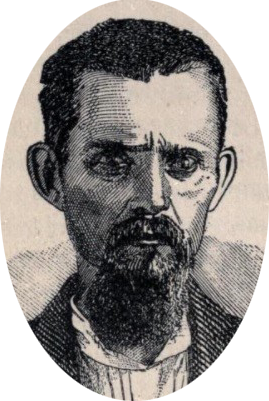 John Jarrett
John Jarrett
John Marion Jarrett was born January 8, 1833 in Kentucky. After his mother died he and his brother were sent to live with their maternal grand-parents in Nelson County, Kentucky. He completed his house carpenter apprenticeship before his 21st birthday.
On a visit to Jackson County, Missouri, John met the Younger family and soon fell in love and married Mary Josephine Younger. Within a year of their marriage the Civil War began and John, along with two cousins and an uncle, enlisted in the Confederate Missouri State Guard. When his enlistment term expired in December 1861, John joined his brother-in-law Cole Younger who was riding with William C. Quantrill. During the spring and summer of 1862 and 1863, John was the Captain of a group of bushwhackers riding under Quantrill and participated in the raids on Lawrence and Baxter Springs, Kansas. The remainder of the war he served as Captain of Company E in the 12th Missouri Cavalry under General J.O. Shelby. John participated in the battles of Prairie Grove, Arkansas, Lexington, Missouri and Hartville, Missouri. Late 1864 John was one of a group, including brother-in-law Cole Younger, who were sent on a secret mission to the Pacific Coast to purchase two vessels for the Confederacy. The four year conflict ended before the purchase was made.
John and Cole took their time returning to Missouri; it is unknown if either participated in the Liberty, Missouri bank robbery in February 1866, although, they most likely knew the plans. John’s first peacetime robbery could have been Lexington, Missouri after which he began the formation of what would become the James-Younger gang. John’s experience leading men during the war, which included Cole Younger and Frank James, would have made him the most likely candidate for Captain of the gang until his departure in 1875.
After robbing the Bank of Huntington in West Virginia on September 6, 1875, John moved his family, Josie and three children, to the West Coast of California. Within a few years his wife Josie, and son Jeff, died. John spent the remainder of his life working, honestly, in the railroad and mining industries. The last fifteen years he spent living in British Columbia, Canada, where his daughters, Marion and Edna, married respectable, hard working men. John died on April 20, 1906 in Greenwood, BC.
